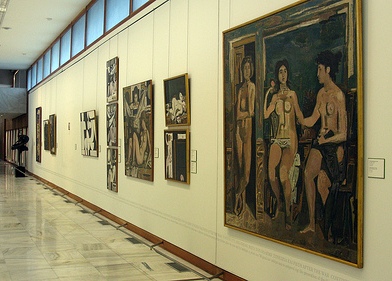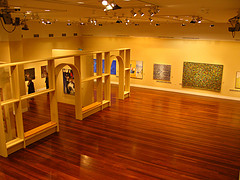

Location: Vasileos Konstantinou 50,
Illsia, Athens
Tel. 210 723 5937
Subway: Evangelismos
Tram train: 3, 13
Open: 9am- 3pm and 6- 9pm Mon and Wed
9am- 3pm Thu- Sat, 10am- 2pm Sun
Closed: public holidays
Official
Site


The National Art Gallery, or the National Pinakothek (Greek: Εθνική Πινακοθήκη) is an art museum in Athens, founded in 1900 and dedicated to Greek and European art from the 14th century to the present. Also known as the Alexandros Soutsos Museum (Greek: Μουσείο Αλεξάνδρου Σούτζου), National Gallery of Greece. The sculptural collection in the post-war period was separated into a separate satellite museum - the National Glyptothek.
The idea of founding the museum arose in 1878, when the
University of Athens donated part of its collection to the
museum. In 1896, a lawyer by profession and an admirer of the
arts, Alexandros Sutsos transferred his private collection to
the ownership of the Greek state. At the time of its opening in
1900, the museum's collection consisted of only 258 works from
the collections of the University of Athens, the Athens
Polytechnic University and Alexandros Soutsos. The first curator
of the museum was the Greek artist Georgios Iakovidis. In
subsequent years, the collection of the gallery was replenished
thanks to other gifts, collections bequeathed by Greek artists
and ordinary citizens. One of the most significant was the gift
of Euripidis Koutlidis, which allowed the museum to fully
present Greek painting of the 19th and 20th centuries.
In
1964, construction began on a new building for the museum along
King Constantine Avenue under the leadership of a group of
architects: Faturis, Mylonas and Moutsopoulos. This is a low
building that has two wings. The museum moved to it in 1976, at
that time its collection already included over 9.5 thousand
exhibits.
The permanent exhibition of the museum occupies the first and
second floors and is represented by artworks of the 19th and
20th centuries. All paintings are presented in chronological
order and grouped thematically. However, the main hall is
dedicated to post-Byzantine painting by representatives of the
so-called Cretan school. In particular, the works of Domenikos
Theotokopoulos, better known by his adopted Spanish name - El
Greco, are exhibited here. Other Renaissance artists include
Jacob Jordaens, Luca Giordano, Giovanni Battista Tiepolo, Jan
Brueghel the Younger, Jan Brueghel the Elder, Lorenzo Veneziano,
Jacopo del Sellaio, and Albrecht Dürer.
Acquaintance with
modern Greek painting begins with the works of artists of the
Ionian Islands. Made with photographic precision, the paintings
tell about the first years of the history of independent Greece.
The most significant artists of this period are Theodoros
Vryzakis and Nikolaos Kounelakis. A separate thematic group is
devoted to modern Greek painters who received their academic art
education in Munich; they form the so-called Munich School of
Greek Painting. Among them are Yakovidis, Georgios, Nikiforos
Litras, Konstantinos Volanakis and Nikolaos Gizis. The
“Children's Concert” (Greek Παιδική Συναυλία) by Georgios
Yakovidis and “The Betrothal” (Greek Τα αρραβωνιάσματα) by
Nikolaos Gyzis stand out especially with their characteristic
accuracy and completeness of the plot.
The art of the
interwar period is represented by the works of artists of the
so-called generation of the 1930s (see Regime 4 August). Its
most prominent representatives are Papaloukas, Spyros,
Tsarouchis, Giannis, Diamantis Diamantopoulos, Moralis, Giannis
and Nikos Hatzikyriakos-Gikas. The second floor is devoted
exclusively to the work of contemporary Greek artists. It is
distinguished by experimentalism, innovative technology and
originality of the plot, among which Greek national features are
not lost at the same time. Of particular interest are the works
of Konstantinos Parthenis and Konstantinos Maleas, who are
considered the founders of Greek Art Nouveau.